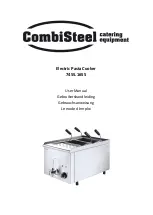
5
NOTE: The reverse osmosis system must provide 1 gal. (3.8 L) of
water per hour to the ice maker for proper ice maker operation. If
a reverse osmosis system is desired, only a whole-house capacity
reverse osmosis system, capable of maintaining the steady water
supply required by the ice maker, is recommended. Faucet
capacity reverse osmosis systems are not able to maintain the
steady water supply required by the ice maker.
If the water pressure to the reverse osmosis system is less than
40 to 60 psi (276 to 414 kPa):
■
Check to see whether the sediment filter in the reverse
osmosis system is blocked. Replace the filter if necessary.
■
Allow the storage tank on the reverse osmosis system to refill
after heavy usage.
If you have questions about your water pressure, call a licensed,
qualified plumber.
Leveling
It is important for the ice maker to be level in order to work
properly. Depending upon where you install the ice maker, you
may need to make several adjustments to level it. You may also
use the leveling legs to lower the height of the ice maker for
undercounter installations.
Tools needed:
Gather the required tools and parts before starting installation.
■
9" level
■
Adjustable wrench
NOTE: It is easier to adjust the leveling legs if you have another
person to assist you.
1. Move the ice maker to its final location.
NOTE: If this is a built-in installation, move the ice maker as
close as possible to the final location.
2. Place the level on top of the product to see if the ice maker is
level from front to back and side to side.
3. Push up on the top front of the ice maker, and then locate the
leveling screws that are on the bottom front of the ice maker.
4. Using an adjustable wrench, change the height of the legs as
follows:
■
Turn the leveling leg to the right to lower that side of the
ice maker.
■
Turn the leveling leg to the left to raise that side of the ice
maker.
NOTE: The ice maker should not wobble. Use shims to add
stability when needed.
5. Push up on the top rear of the ice maker and locate the
leveling legs that are on the bottom rear of the ice maker.
6. Follow the instructions in Step 4 to change the height of the
legs.
7. Use the level to recheck the ice maker to see that it is even
from front to back and side to side. If the ice maker is not
level, repeat steps 2 to 5. If the ice maker is level, go to the
“Connect Water Supply” section.
Connect Water Supply
Read all directions before you begin.
IMPORTANT:
■
Plumbing shall be installed in accordance with the
International Plumbing Code and any local codes and
ordinances.
■
Use copper tubing or Whirlpool supply line, Part Number
8212547RP, and check for leaks.
■
Install tubing only in areas where temperatures will remain
above freezing.
Tools needed
Gather the required tools and parts before starting installation:
■
Flat-blade screwdriver
■
⁷⁄₁₆
" and
¹⁄₂
" open-end wrenches or two adjustable wrenches
■
¹⁄₄
" nut driver
NOTE: Do not use a piercing-type or
³⁄₁₆
" (4.76 mm) saddle valve
which reduces water flow and clogs more easily.
Connecting the Water Line
1. Turn off main water supply. Turn on nearest faucet long
enough to clear line of water.
2. Using a
¹⁄₂
" copper supply line with a quarter-turn shutoff valve
or the equivalent, connect the ice maker as shown.
NOTE: To allow sufficient water flow to the ice maker a
minimum
¹⁄₂
" size copper supply line is recommended.
3. Now you are ready to connect the copper tubing. Use
¹⁄₄
"
(6.35 mm) OD soft copper tubing for the cold water supply.
■
Ensure that you have the proper length needed for the job.
Be sure both ends of the copper tubing are cut square.
■
Slip compression sleeve and compression nut on copper
tubing as shown. Insert end of tubing into outlet end
squarely as far as it will go. Screw compression nut onto
outlet end with adjustable wrench. Do not overtighten.
A. Bulb
B. Nut
A. Compression sleeve
B. Compression nut
C. Copper tubing
A
B
B
C
A






































